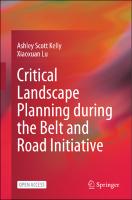Critical Landscape Planning during the Belt and Road Initiative
| dc.contributor.author | Kelly, Ashley Scott | |
| dc.contributor.author | Lu, Xiaoxuan | |
| dc.date.accessioned | 2021-10-13T13:54:34Z | |
| dc.date.available | 2021-10-13T13:54:34Z | |
| dc.date.issued | 2021 | |
| dc.identifier | ONIX_20211013_9789811640674_53 | |
| dc.identifier | OCN: 1272954907 | |
| dc.identifier.uri | https://library.oapen.org/handle/20.500.12657/51004 | |
| dc.description.abstract | This open access book traces the development of landscapes along the 414-kilometer China–Laos Railway, one of the first infrastructure projects implemented under China’s Belt and Road Initiative (BRI) and which is due for completion at the end of 2021. Written from the perspective of landscape architecture and intended for planners and related professionals engaged in the development and conservation of these landscapes, this book provides history, planning pedagogy and interdisciplinary framing for working alongside the often-opaque planning, design and implementation processes of large-scale infrastructure. It complicates simplistic notions of development and urbanization frequently reproduced in the Laos–China frontier region. Many of the projects and sites investigated in this book are recent “firsts” in Laos: Laos’s first wildlife sanctuary for trafficked endangered species, its first botanical garden and its first planting plan for a community forest. Most often the agents and accomplices of neoliberal development, the planning and design professions, including landscape architecture, have little dialogue with either the mainstream natural sciences or critical social sciences that form the discourse of projects in Laos and comparable contexts. Covering diverse conceptions and issues of development, including cultural and scientific knowledge exchanges between Laos and China, nature tourism, connectivity and new town planning, this book also features nine planning proposals for Laos generated through this research initiative since the railway's groundbreaking in 2016. Each proposal promotes a wider "landscape approach" to development and deploys landscape architecture’s spatial and ecological acumen to synthesize critical development studies with the planner's capacity, if not naive predilection, to intervene on the ground. Ultimately, this book advocates the cautious engagement of the professionally oriented built-environment disciplines, such as regional planning, civil engineering and landscape architecture, with the landscapes of development institutions and environmental NGOs. | |
| dc.language | English | |
| dc.subject.classification | thema EDItEUR::R Earth Sciences, Geography, Environment, Planning::RG Geography::RGC Human geography | en_US |
| dc.subject.classification | thema EDItEUR::A The Arts::AM Architecture::AMV Landscape architecture and design | en_US |
| dc.subject.classification | thema EDItEUR::R Earth Sciences, Geography, Environment, Planning::RP Regional and area planning::RPC Urban and municipal planning and policy | en_US |
| dc.subject.other | critical landscape planning | |
| dc.subject.other | transdisciplinary design | |
| dc.subject.other | Belt and Road Initiative | |
| dc.subject.other | landscape ecology | |
| dc.subject.other | critical cartography | |
| dc.subject.other | China-Laos Railway | |
| dc.subject.other | Greater Mekong Subregion | |
| dc.subject.other | transnational infrastructure | |
| dc.subject.other | development studies | |
| dc.subject.other | Golden Triangle | |
| dc.subject.other | Open Access | |
| dc.title | Critical Landscape Planning during the Belt and Road Initiative | |
| dc.type | book | |
| oapen.identifier.doi | 10.1007/978-981-16-4067-4 | |
| oapen.relation.isPublishedBy | 6c6992af-b843-4f46-859c-f6e9998e40d5 | |
| oapen.relation.isFundedBy | 33edbeb2-314a-4af1-94a0-27b52592cfb4 | |
| oapen.relation.isbn | 9789811640674 | |
| oapen.imprint | Springer Singapore | |
| oapen.pages | 249 | |
| oapen.grant.number | [grantnumber unknown] |

